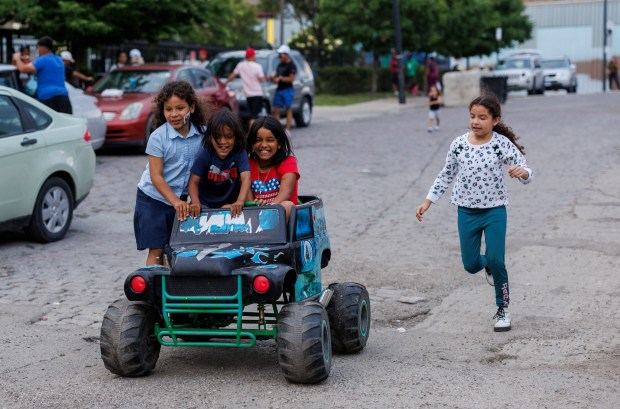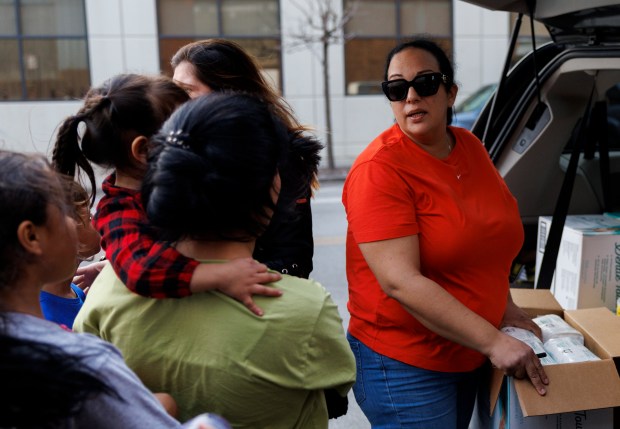Mayor Brandon Johnson’s administration has begun the process of removing from city shelters dozens of migrant families, including those with children who attended Chicago Public Schools.
Just days after the CPS school year ended, officials this week began the eviction process to continue to ease pressure on overstretched resources in shelters run by the city and state.
It’s the second significant wave of forced removals at shelters since the city began ordering mostly single men and some single women to find housing elsewhere. Now, entire families are being told the same.
Homeless advocates and experts said moving the families from shelters could be detrimental to the children’s sense of stability. For many of the migrant children, school has been the only structure in their lives after traveling for months to the United States, the experts said.
“Going through this eviction process is stressful and very challenging for them,” said Alyssa Phillips, education attorney for the Chicago Coalition for the Homeless.
More than 43,000 migrants have arrived in Chicago since August 2022 when Republican Gov. Greg Abbott of Texas first ordered asylum-seekers be shuttled to Chicago and other northern cities to share the costs of the high number of people as well as to make a political statement about the nation’s immigration policies.
The migrants — who mostly come from Venezuela — are escaping their country of origin’s economic and political turmoil caused by tanking oil prices and a far-left federal government. Chicago has spent about $150 million so far to shelter and feed those who have arrived here.
In mid-March, Johnson’s administration began enforcing a limit of 60 days for migrants to stay at city shelters. At the time, the city made exceptions on a case-by-case basis, including for medical issues or because some asylum-seekers were in the process of securing housing. Families with children had been given three, 30-day extensions to ease disruptions.
Phillips said families were originally supposed to be evicted in the middle of the school year, but she and other advocates pushed back.
Friday was the last day of school and family evictions began this past Monday. Four individuals exited the shelter system on Tuesday, the day after evictions started, according to a spokesperson at the city’s Department of Family & Support Services. About 40 people are expected to leave in the next week.
Following a Chicago City Council meeting Wednesday, when asked how migrant children’s education might be disrupted by evictions, Johnson, a former CPS teacher, didn’t directly answer the question and instead said his ultimate goal was to help migrant families find houses of their own.
“The standard is not shelter in perpetuity,” he said. “The standard and the expectation is that people can actually live sustainable, fruitful lives in Chicago or anywhere else in America.”
Once migrant families are evicted from shelters, they are asked to go to the city’s “landing zone” in the West Loop, where they are allowed to temporarily sleep on CTA buses in the landing zone’s parking lot while they reapply to reenter the shelter system.
On Wednesday, many migrant families expressed uncertainty about how that process will work, or if shelter space will be available. As of Wednesday, of 966 total people evicted from shelters, more than 55% had reentered the system — a collection of 17 warehouses and once-shuttered buildings now housing 6,722 people.
Maria Perez, a volunteer with Southwest Collective who works with migrants at the shelter on the Lower West Side, said she has seen several families leave the shelters this week. She said she last saw those families standing on nearby street corners with their belongings and waiting for Uber drivers to pick them up.
“They’ve already made so many journeys to make it here,” she said. “I can’t imagine what they’re thinking.”
City officials have said repeatedly that they give migrants exit dates to push them toward finding their own, independent housing options. The city officials have said they’ve coupled the eviction process with wraparound services from case managers and nonprofit organizations.
But those staying in shelters on Wednesday said they hadn’t received any guidance on where to find housing or resources.
Virginia de Jesus, a 27-year-old from Valencia, Venezuela, said she and her son arrived at a shelter on the Lower West Side two days ago and they have yet to receive any support from shelter workers. They were told by officials at the shelter that they needed to leave in 60 days, which de Jesus said was not enough time to find independent housing.
“The workers seem to be in their own world,” she said. “We don’t know where to look for help. We really don’t know what to do.”
Her 6-year-old son Sebastian, who wore a blue and red cape, occupied himself by sweeping the pavement outside the shelter. In his home city, his mother said, he went to school for maybe two hours a day, three days a week.
She said she hoped to register him for school but wasn’t sure where she would be living in a month and a half.

The large population of asylum-seekers who have arrived in Chicago seeking assistance has contributed to record rates of homelessness in the city. More than 18,000 people experienced homelessness according to a point-in-time count conducted in late January. That’s a threefold increase from last year.
The numbers are slightly skewed because, at the time of the count, the city was sheltering a record numbers of migrants, spurred by an increase in border crossings in the winter. The count also doesn’t include migrants who were “doubled up,” or sharing a house with others.
But the count indicates a trend: following the end of a state-funded rental assistance program, the migrant population in Chicago is increasingly overlapping with people experiencing homelessness. In fact, city and state officials and nonprofit leaders are in the preliminary stages of a plan to combine the legacy homeless shelter system with the shelter system for migrants.
Homeless advocates said combining the shelter systems will take time and coordination but will be beneficial for all unhoused Chicagoans. Still, those working with migrants said there will be large logistical hurdles, such as translation services.
This has more implications for children, said Darcey Merritt, a professor at the University of Chicago Crown Family School of Social Work.
“They’re at some really sensitive developmental stages in their lives,” Merritt said. “They will end up behind in school.”
The Chicago Public Schools system is federally required to support the enrollment and education of students who are homeless or in temporary living situations. For migrant children who move, this means providing free transportation to stay at the school near their shelter if they wish.

There were 23,470 students in temporary living situations enrolled at the end of May — a 46% increase from last May and the most ever recorded at this time of year, according to data provided by the Chicago Coalition for the Homeless. CCH attributes the increase in part to the thousands of migrant children who have arrived over the past year.
With so many students in volatile living situations, migrant advocates said it will be important to communicate that children have the right to stay in the same school. They hope to connect them with summer programming.
Advocates, however, said it is virtually impossible to talk to migrants while they’re staying on buses at the landing zone.
Gleidis Calderon, a 22-year-old mother from Maracay, Venezuela, said her eviction date is July 17, but she doesn’t know how to find stable housing.
On Wednesday afternoon, she sat in the shade of a driveway by the shelter on the Lower West Side with her 7-year-old daughter Eudima. She said her daughter has been restless since school let out.
With nothing to occupy their time, Calderon said children inside the shelter were fighting. She’d left Venezuela seeking a safer life only to find herself worried about the wellbeing of her kids.
“Here, they aren’t doing anything. They aren’t learning anything,” she said.
Chicago Tribune’s Alice Yin contributed.





